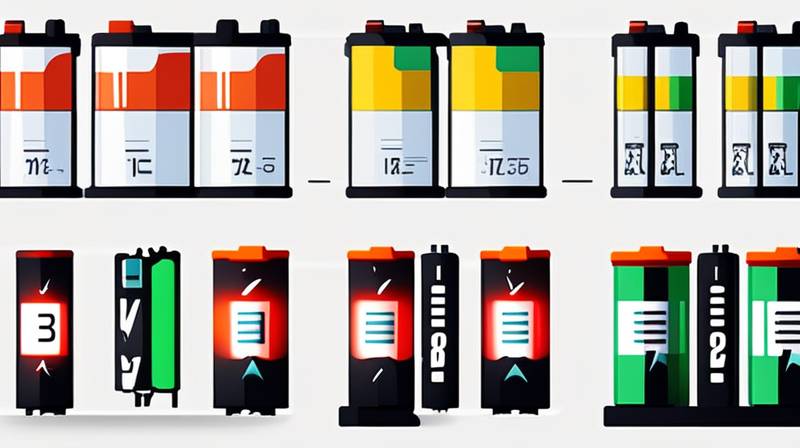
The appropriate voltage for energy storage power batteries varies based on several factors, 1. Battery chemistry, 2. Application requirement, 3. Efficiency considerations, 4. Safety standards.
- BATTERY CHEMISTRY
Understanding battery chemistry is crucial when determining the optimal voltage for energy storage. Lithium-ion batteries, prevalent in various applications from electric vehicles to renewable energy systems, typically operate at voltages ranging from 3V to 4.2V per cell. The nominal voltage of a lithium-ion battery is often around 3.7V, making them suitable for high energy density requirements. Conversely, lead-acid batteries operate at lower voltages, typically around 2V per cell, translating to 12V for a standard battery setup.
The chemistry of the battery not only influences the voltage but also affects the charging and discharging profiles. For example, lithium polymer batteries, which are a type of lithium-ion, can also achieve higher voltages but may have different safety and performance characteristics. It is essential to select batteries appropriate for the specific energy storage application. This could involve assessing energy demands alongside potential voltage outputs to ensure reliable performance.
- APPLICATION REQUIREMENTS
Voltage considerations are heavily dependent on specific application requirements. In renewable energy systems, such as solar or wind energy, the voltage must match the output of the solar panels or the characteristics of the wind turbine generators. For solar applications, systems often operate on 48V or 60V configurations, which efficiently meet the demands of most inverters. When systems scale up or when there is a need for greater energy storage capacity, higher voltages are employed, such as 400V or higher, which contributes to reducing current and minimizing losses.
In contrast, in smaller-scale applications like portable electronics or drones, maintaining a lower voltage, usually 3.7V to 14.8V, suffices for optimal performance. The importance of adhering to specific voltage requirements stems from the fact that too high or too low voltages can lead to performance inefficiencies or even catastrophic failures, making it imperative to align the battery’s voltage with the end application’s characteristics.
- EFFICIENCY CONSIDERATIONS
Efficiency is another paramount angle to explore when discussing optimal battery voltages. Higher voltages can often facilitate lower currents, which, in turn, reduces resistive losses. The important equation ( P = IV ) (Power = Current x Voltage) illustrates that for the same power output, increasing voltage allows for a decrease in current. This is particularly beneficial in high-capacity systems where electrical resistance plays a significant role in energy losses.
However, it is equally vital to assess the compatibility of the entire system with the designated voltage. For example, inverter efficiencies significantly dictate the relationship between voltage and efficiency in energy storage systems. Care must be taken to ensure that when planning a system, the chosen voltage is suitable for the inverters and converters used. Mismatch can lead to suboptimal performance, elevated temperatures, and possible equipment damage. Effective system management of voltages aligns with enhancing overall performance and longevity of both storage solutions and applications.
- SAFETY STANDARDS
Safety standards present yet another critical dimension in the discourse on optimal voltages for battery storage. As voltages increase, especially over 60V, the risks of electric shock, explosion, or thermal runaway tendencies rise significantly. It is imperative to comply with established safety norms such as IEC and UL certifications that designate maximum safe operating voltages for different battery types as well as charging methods.
While exploring high-voltage solutions can be beneficial for energy output, safety protocols must enforce proper installation and handling practices. Additionally, active and passive safety mechanisms—such as thermal fuses, overvoltage protection circuits, and management systems—are crucial to mitigating risks associated with high-voltage energy storage. Having a robust safety framework ensures that both commercial and residential systems operate within safe voltage thresholds.
- CONCLUSION
Determining the most advantageous voltage for energy storage power batteries encompasses a multidimensional analysis that takes various factors into account. The intricacies surrounding battery chemistry, application requirements, efficiency considerations, and safety standards create a complex web of decision-making that affects end-user productivity and satisfaction. Lithium-ion technologies, for instance, exhibit a significant variance in voltage and can be tailored for specific applications, depending on the energy density and operational capacities required. Conversely, lead-acid technologies usually offer lower voltage outputs but may provide advantages in cost and robustness for certain applications.
When optimizing voltage in conjunction with system design, the implications stretch beyond mere performance optimization; they also encompass long-term operational costs, charging times, and user safety. Meeting specific voltage requirements is not just about efficiency—it’s also about adhering to strict safety guidelines and ensuring compatibility across the entire energy storage ecosystem. Striking a balance between all these variables allows stakeholders to achieve effective energy storage solutions that safely and efficiently meet their demands.
The alignment of voltage with both operational needs and safety standards ensures that energy storage systems function optimally without unnecessary risks. Therefore, stakeholders must engage in meticulous planning while continually evolving their strategies to adapt to new technologies. This ensures a resilient, effective energy storage infrastructure capable of supporting modern energy needs while adhering to a future-oriented, inclusive safety-first approach.
Original article by NenPower, If reposted, please credit the source: https://nenpower.com/blog/how-many-volts-is-good-for-energy-storage-power-batteries/


